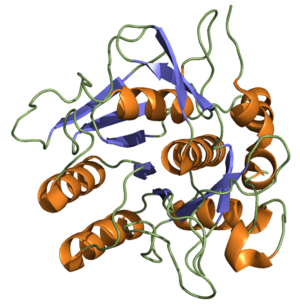Nattokinase facts for kids
Nattokinase (pronounced NUH-toh-KIN-ayss) is a special type of enzyme. It is taken from a traditional Japanese food called nattō. Nattō is made by a process called fermentation. This happens when a specific bacterium, Bacillus natto, is added to boiled soybeans. This bacterium is also what produces the nattokinase enzyme. While other soy foods have enzymes, only nattō contains this particular nattokinase enzyme.
Contents
Understanding Nattokinase
Nattokinase is a powerful enzyme. Even though its name sounds like "kinase," it's actually a type of enzyme called a serine protease. It's very similar to another enzyme called subtilisin. The name "nattokinase" comes from nattōkin, which is the Japanese name for the bacterium Bacillus subtilis var natto.
How Nattokinase Affects Blood
When nattokinase comes into contact with human blood, it can help break down blood clots. It does this by making another important substance, called plasmin, more active. Plasmin is naturally found in our bodies and helps to dissolve blood clots. Nattokinase also works by stopping something called PAI-1 (plasminogen activator inhibitor 1), which normally slows down clot dissolving. This means nattokinase helps the body keep blood flowing smoothly.
Can We Use Nattokinase?
Scientists have studied nattokinase to see if it stays active when people swallow it. Even though most proteins like enzymes get broken down in our stomach, some research suggests that nattokinase might still be active after being eaten.
Nattokinase as a Supplement
Today, nattokinase is often sold as a dietary supplement. This means you can buy it in pills or capsules.
How Nattokinase is Made Now
In the past, nattokinase was only taken directly from nattō. But now, scientists can make it in large amounts using a method called recombinant production. This means they can produce the enzyme in big batches without needing to make lots of nattō. There are a few main companies around the world that make nattokinase, including Contek Life Science, Daiwa Pharmaceutical, and the Japan Bio Science Laboratory.


